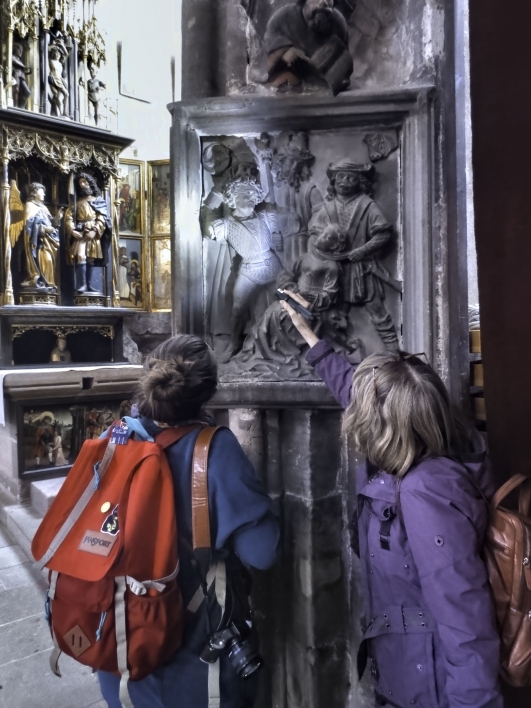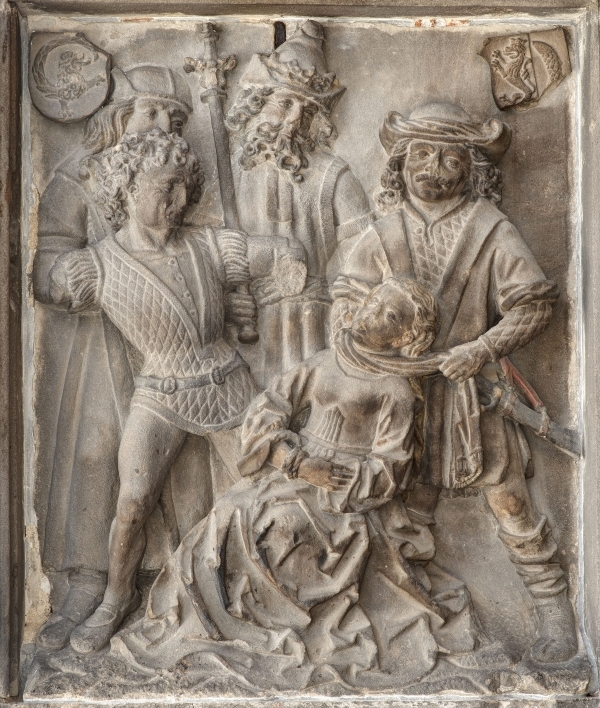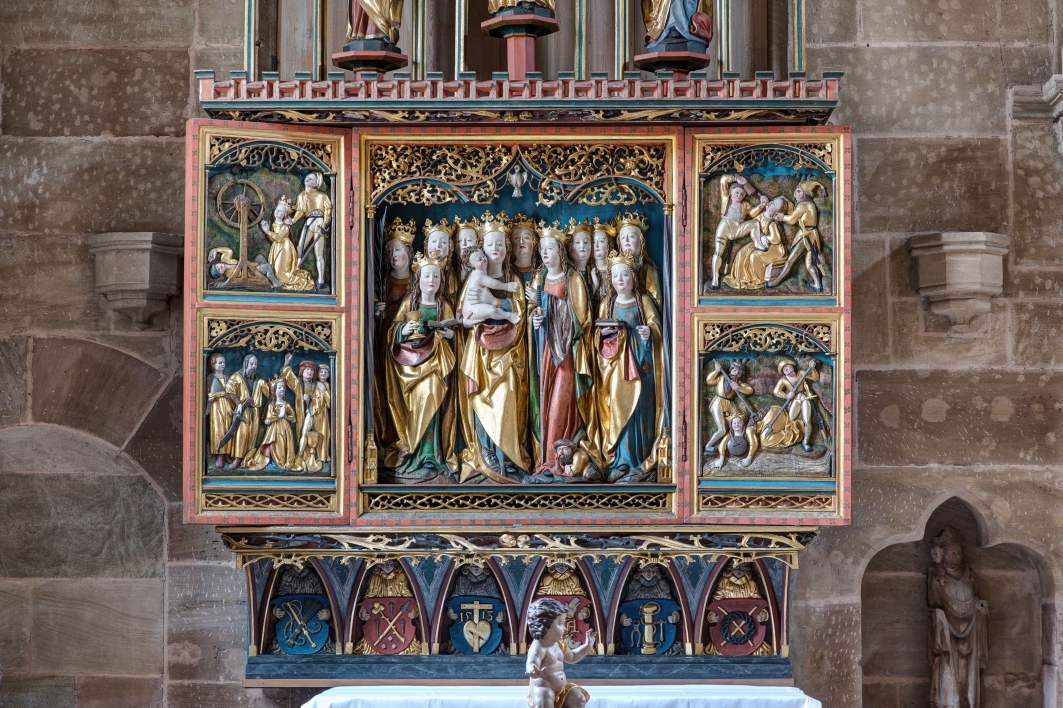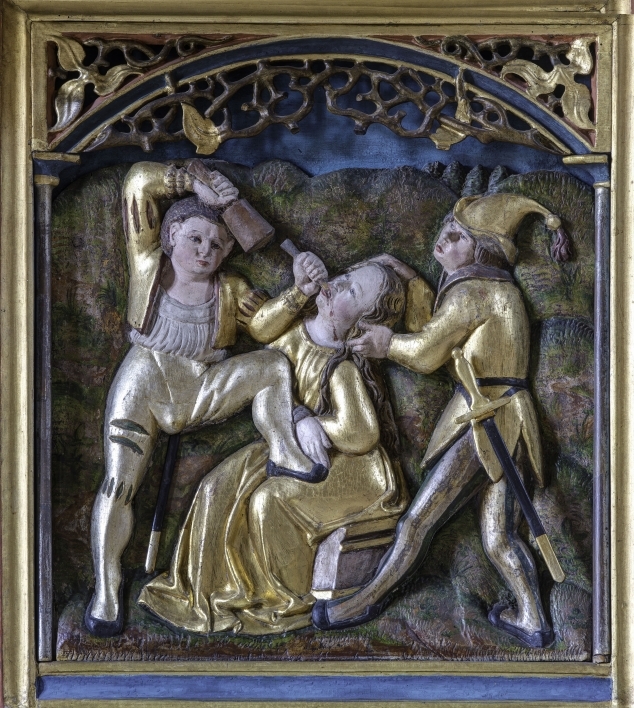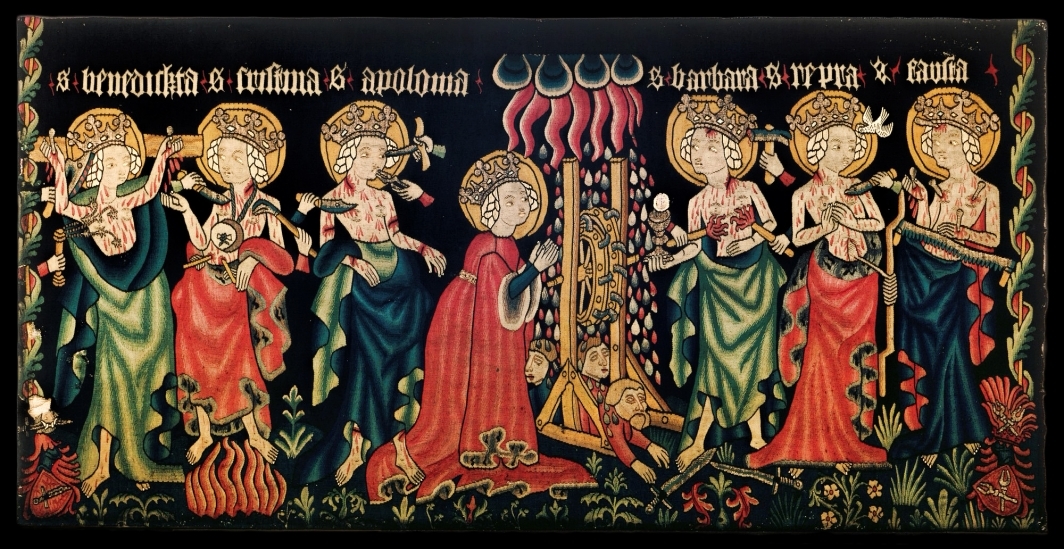Intergenerational study sparks new art theory
ASU art history Professor Corine Schleif proffers a new theory on an old sculpture

The image in stone relief is arresting, but not for its beauty. A woman on bended knees, head tilted upward, is restrained by a man from behind while another man at her front appears to reach his arms out toward her. It’s hard to know exactly what his arms are meant to be doing, though — at some point in history, they were chiseled away.
For at least two centuries, scholars have accepted the idea that the man’s arms are reaching out to grasp the neck of the woman, at various times presumed to be either Saint Beatrice or Saint Ludmila, both of whom were strangled to death according to Christian canon.
Now, after taking a closer look at the work of art displayed on a stone pillar in St. Lorenz church in Nuremberg, Germany, Arizona State University art history Professor Corine Schleif is proffering a new theory as to the woman’s identity. Schleif believes it is Saint Apollonia, patron saint of dentists and those suffering from tooth ailments, whose own teeth are said to have been violently extracted or shattered as part of her torture and murder at the hands of an Alexandrian mob in the third century.
Schleif described the day during the summer of 2017 that she and ASU doctoral candidate Bevin Butler took a tour of Nuremberg churches while conducting research there, when the realization struck her “like the scales falling from her eyes.”
Earlier in the day, Schleif had accompanied Butler to a church where they observed tapestries as part of Butler’s research for her dissertation on nuns' textiles. One tapestry in particular portrays six so-called virgin martyrs, one of whom is known to be Saint Apollonia, depicted with a pair of pliers in her mouth. With that image fresh in their minds, Schleif and Butler next visited St. Lorenz church.
There, Schleif was eager to view and discuss with her student some of the works of late-14th-early-15th century German sculptor Adam Kraft, about whom she has been working on a book for several years. In addition to the enormous Eucharistic tabernacle, they also stopped to take in the defaced stone relief.
“We were standing in front of it,” Schleif said, “and I was telling Bevin, ‘OK, you see how this person's arms are missing here?’ — when you’re an art historian, you do these silly things like act out works of art — so I said, ‘We have to imagine what his arms were doing and why he's in this pose and what the rest of the sculpture looked like that's missing.’
“And then all of a sudden I thought, ‘What were his arms doing?’”
The pair stopped to consider the question. Upon closer inspection, they realized the man behind the woman wasn’t strangling her with the piece of cloth he held — he was restraining her.
“We were literally, the two of us, sort of miming it out,” Butler said. “Which I’m sure was entertaining for everybody there trying to have nice vacation and here we are acting out this weird martyrdom.”
What’s more, there seemed to be a chunk of stone sticking out of the woman’s mouth.
“The mouth has some stone that's left on it that can't just be her mouth,” Schleif said. “Her lips are parted and there’s a bunch of stone there that wouldn't belong there unless there was something else there, attached to her mouth.”
Recalling the image of Saint Apollonia on the tapestry, Schleif’s suspicion turned toward certainty.
To be absolutely sure, she traveled to a town a few kilometers outside of Nuremberg to view a panel painting there that was thought to be based on the Kraft stone relief. Fortunately, the image on the panel painting is still completely intact, including the arms of the man, one raised high above his head, chiseling away at the hapless saint’s teeth.
“It was clearly Apollonia,” Schleif said.
Saint Apollonia is one of a group of Christian female martyrs, known as the virgin martyrs because of their persecution for rejecting marriage in order to remain pure for Christ. All met equally terrible fates, ranging from the aforementioned strangulations to beheadings to eye-gouging and worse.
It is not known when or why the defacing of the St. Lorenz stone relief occurred but Schleif posits the reason may be as simple as the fact that it’s just not a very pleasant scene.
“Of course nobody can ever prove this,” Schleif said. “But I think it was (defaced) because people had a hard time looking at it. In that way, art becomes sort of interactive, because if you can't bear looking at that all the time … one thing to do would be to take a hatchet to it. And that essentially makes it into a less harmless work of art.”
Schleif has written about the phenomenon, which she refers to as iconoclash, and intends in her forthcoming book on Kraft to explore other ways people interact with art and how perceptions of what is acceptable interaction have changed over time.
“It's kind of interesting when people became concerned about preserving art or when they changed pieces out and thought nothing of replacing them,” she said. “They didn't always react as we do now, which is to put it in a museum, don't touch it, revere it.”
Schleif feels the defacing of the St. Lorenz relief is emblematic of the value of taking the time to reevaluate parts of history we thought we knew.
“I think that we should look at these things more carefully with respect to misogyny and gender issues,” she said. “This image is pretty hard to look at. It forces viewers into a very uncomfortable position, and somebody at some time didn't like that position and decided to do something about it.
“I think it's kind of a wakeup call that these works were not so far removed, that people were troubled by them. It makes us think about these notions of gender and sort of the erotics of power, which I think is what must have been going on there.”
For Schleif, the revelation of Saint Apollonia’s identity in the St. Lorenz relief is the culmination of one aspect of her scholarship coming full circle. She was a graduate student when she first became acquainted with the St. Lorenz stone relief, and at the time, most scholars agreed Saint Beatrice was the woman in question. But her professor and mentor, a historian of Bohemian aristocracy, believed her to be Saint Ludmila from Mělník, a town in the Central Bohemian Region of the Czech Republic.
Schleif did some research and found that when Kraft carved the St. Lorenz relief, around 1500, Bohemia had substantial influence in Nuremberg. She also found that there were many Saint Ludmilas to be found in Nuremberg then but not a single Saint Beatrice. Convinced, she wrote the identity of the woman into her dissertation as Saint Ludmila.
A generation later, observing the relief with her own grad student, Schleif was compelled to reconsider.
“My student had been working on St. Apollonia in a completely different context but we were constantly in discussions about her work,” she said. “Had that not been the case, maybe I wouldn't have come up with this idea.”
“Corine is one of my many heroes in life,” said Butler, who is also an ASU School of Art faculty associate. “She is brilliant and knows everything there is to know about the churches in Nuremburg. And that was my first time to Germany, and I had Corine, the master of 15th and 16th century art showing me around this church. It was sort of a dream moment. (This discovery is) something we don’t always get to have as scholars of old stuff.”
Schleif echoed the importance of intergenerational research and collaboration, as well as the opportunity for students to witness historical items firsthand.
“Even though all the digital access is so wonderful today, sometimes you really have to get those volumes from the shelf and put them on your desk and go through them with your hands,” she said. “It’s not the same just having them on your screen.
"I think that looking at this particular sculpture with Bevin really shows that you have to go back and look at the originals, even when you've seen them so often. Because you overlook things. Or you just take it for granted that it's the way that everybody else said it was. So I think there's still a lot of discoveries left for our students to make.”
Top photo: ASU Professor Corine Schleif instructs graduate student Bevin Butler on the finer details of a stone relief sculpture in Saint Lorenz church in Nuremberg, Germany. Photo courtesy Corine Schleif.
More Arts, humanities and education
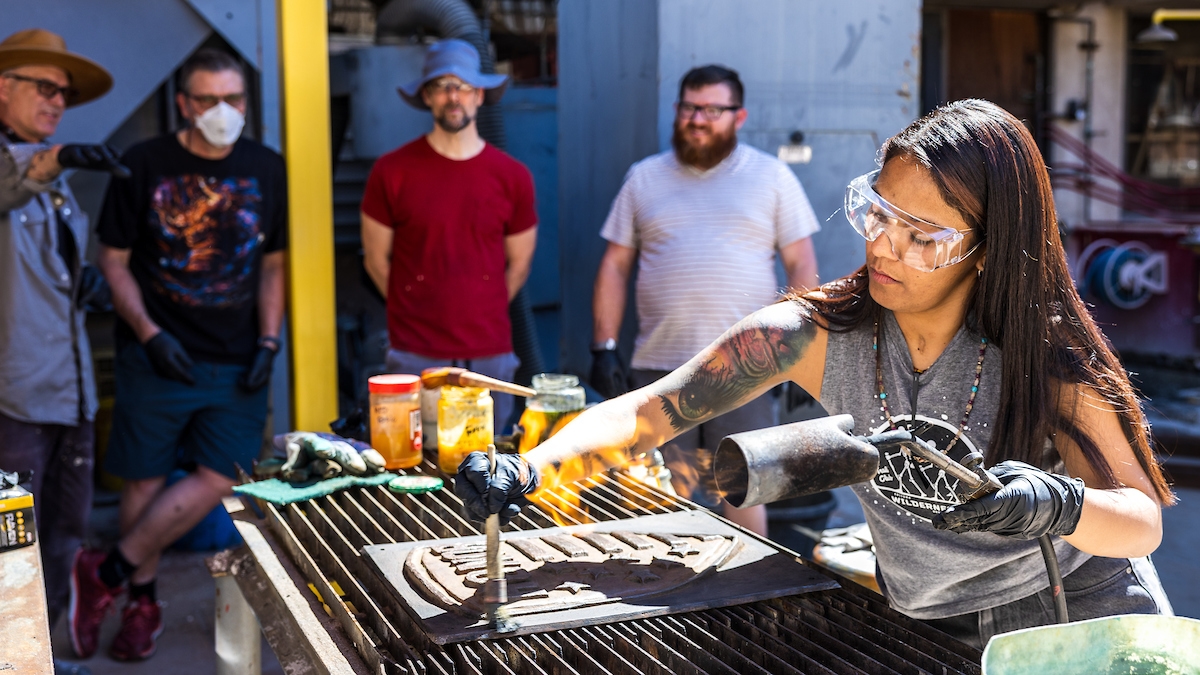
'Devils in the Metal': ASU vet leads iron cast workshop for former service members
Bruce Ward believes everyone has a symbol of strength or resilience, and they have an obligation to find it. His happens to be a paper crane in an ocean wave. “It’s the idea that we are the…
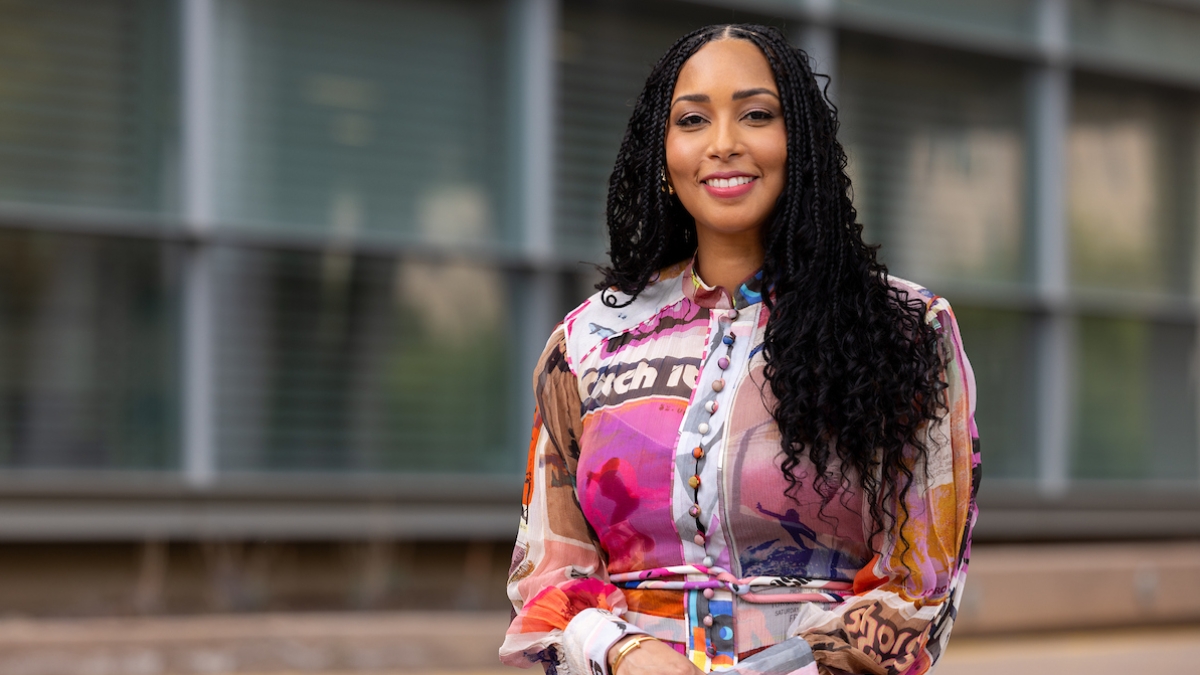
ASU English professor wins Guggenheim Fellowship for poetry
The awards — and opportunities — keep piling up for Safiya Sinclair, an associate professor in Arizona State University’s Department of English. In mid-April, Sinclair received one of 188 Guggenheim…

Designer behind ASU’s brand named newest Herberger Institute Professor
Bruce Mau, co-founder and CEO of the Chicago-based holistic design consultancy Massive Change Network, has joined Arizona State University’s Herberger Institute for Design and the Arts as its newest…
